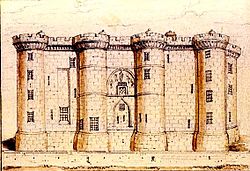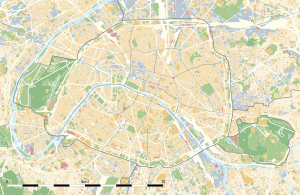Bastille
| Bastille | |
|---|---|
| Paris, France | |

East view of the Bastille
|
|
| Coordinates | 48°51′12″N 2°22′09″E / 48.853333°N 2.369167°E |
| Type | Medieval fortress, prison |
| Site information | |
| Condition | Destroyed, limited stonework survives |
| Site history | |
| Built | 1370–1380s |
| Built by | Charles V of France |
| Demolished | 1789–90 |
| Events |
Hundred Years' War Wars of Religion Fronde French Revolution |
The Bastille (French pronunciation: [bastij]) was a fortress in Paris, known formally as the Bastille Saint-Antoine. It played an important role in the internal conflicts of France and for most of its history was used as a state prison by the kings of France. It was stormed by a crowd on 14 July 1789, in the French Revolution, becoming an important symbol for the French Republican movement, and was later demolished and replaced by the Place de la Bastille.
The Bastille was built to defend the eastern approach to the city of Paris from the English threat in the Hundred Years' War. Initial work began in 1357, but the main construction occurred from 1370 onwards, creating a strong fortress with eight towers that protected the strategic gateway of the Porte Saint-Antoine on the eastern edge of Paris. The innovative design proved influential in both France and England and was widely copied. The Bastille figured prominently in France's domestic conflicts, including the fighting between the rival factions of the Burgundians and the Armagnacs in the 15th century, and the Wars of Religion in the 16th. The fortress was declared a state prison in 1417; this role was expanded first under the English occupiers of the 1420s and 1430s, and then under Louis XI in the 1460s. The defences of the Bastille were fortified in response to the English and Imperial threat during the 1550s, with a bastion constructed to the east of the fortress. The Bastille played a key role in the rebellion of the Fronde and the battle of the faubourg Saint-Antoine, which was fought beneath its walls in 1652.
...
Wikipedia

